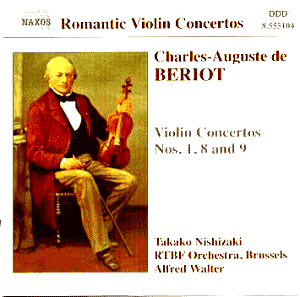Virtuoso, composer, teacher and Royal Violinist de
Bériot was one of the progenitors of the Franco-Belgian school.
Once popular but now neglected his studies have been used as pedagogic
material by generations of aspiring students who also played the graceful
concertos as an entrée into the concert world. Though the virtuosic
element in his works is pronounced – left hand pizzicati, treacherous
harmonics and some scordatura (the First Concerto for example was originally
intended for a violin tuned a semitone higher) – de Bériot’s
primary gift was lyrical. He was hardly a Romantic avant la lettre
because the First Concerto was published in 1829 but he did anticipate
certain elements of Mendelssohnian Romanticism – the linked movement
for example – even if the level of his works falls well short of the
far greater composer.
These three Concertos date from 1829-1858. The First
and Ninth are congenial and compact, the former in one movement, the
latter in the accustomed three. The Eighth Concerto is the most substantial
and is in three movements, played without a break. Dedicated to Leopold
I, first King of the Belgians, the First, known as the Military,
opens in the style of an operatic paraphrase with considerable elegance
and some discursive technical demands. It expands to take in a stout
cymbal accented episode, the solo violin supported by operatically expectant
strings. The violin expounds on some lyrical lower string moments –
de Bériot exploiting registral plangency with accustomed familiarity
– before a mildly Paganinian conclusion, with rollicking left hand pizzicati.
It’s difficult to maintain absolute integrity of intonation here. At
twelve minutes this is, in the classical sense, a concerto of course
but might better be thought of as a rather scenic Concertante piece
or a Konzertstück.
The Eighth Concerto, de Bériot’s Opus 99, is
again in D major and a more obviously mature example. The flute makes
its presence felt, nicely blending with the solo violin (good balancing
by player, conductor and engineer). The solo line itself is attractively
lyric but somewhat unvaried and undifferentiated. It develops a (albeit
rather repetitious) winningly robust impress though in this performance
the conclusion to the Allegro maestoso sounds a bit undernourished.
It could certainly go with greater conviction. The long lined expressive
material of the Andantino with its descending motifs sets the stage
for some operatic delicacy before a boisterous Rondo finale – full of
avuncular certainty. The Ninth followed soon after but is less satisfying.
The first movement is over before you notice it and the main weight
falls on the Adagio. This is strongly reverential without becoming unduly
emotive, little right hand roulades giving distinctive technical interest.
The orchestration here is deliberately reduced.
Nishizaki deals with most of the technical flourishes
with elegant aplomb. Once or twice I felt a lack of weight in the tuttis
and a feeling that not enough is made of de Bériot’s orchestral
curve. But these are adept performances of works that are more than
of mere antiquarian interest. They certainly deserve their place in
the history of the early Romantic Violin Concerto.
Jonathan Woolf
